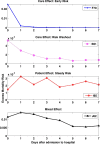Do variations in hospital mortality patterns after weekend admission reflect reduced quality of care or different patient cohorts? A population-based study
- PMID: 24163392
- PMCID: PMC3933164
- DOI: 10.1136/bmjqs-2013-002218
Do variations in hospital mortality patterns after weekend admission reflect reduced quality of care or different patient cohorts? A population-based study
Abstract
Background: Proposed causes for increased mortality following weekend admission (the 'weekend effect') include poorer quality of care and sicker patients. The aim of this study was to analyse the 7 days post-admission time patterns of excess mortality following weekend admission to identify whether distinct patterns exist for patients depending upon the relative contribution of poorer quality of care (care effect) or a case selection bias for patients presenting on weekends (patient effect).
Methods: Emergency department admissions to all 501 hospitals in New South Wales, Australia, between 2000 and 2007 were linked to the Death Registry and analysed. There were a total of 3 381 962 admissions for 539 122 patients and 64 789 deaths at 1 week after admission. We computed excess mortality risk curves for weekend over weekday admissions, adjusting for age, sex, comorbidity (Charlson index) and diagnostic group.
Results: Weekends accounted for 27% of all admissions (917 257/3 381 962) and 28% of deaths (18 282/64 789). Sixteen of 430 diagnosis groups had a significantly increased risk of death following weekend admission. They accounted for 40% of all deaths, and demonstrated different temporal excess mortality risk patterns: early care effect (cardiac arrest); care effect washout (eg, pulmonary embolism); patient effect (eg, cancer admissions) and mixed (eg, stroke).
Conclusions: The excess mortality patterns of the weekend effect vary widely for different diagnostic groups. Recognising these different patterns should help identify at-risk diagnoses where quality of care can be improved in order to minimise the excess mortality associated with weekend admission.
Keywords: Health Services Research; Patient Safety; Quality Measurement.
Figures


Comment in
-
It's not you, it's me: time to narrow the gap in weekend care.BMJ Qual Saf. 2014 Mar;23(3):180-2. doi: 10.1136/bmjqs-2013-002674. Epub 2013 Dec 3. BMJ Qual Saf. 2014. PMID: 24299733 No abstract available.
References
-
- Aylin P, Yunus A, Bottle A, et al. Weekend mortality for emergency admissions. A large, multicentre study. Qual Saf Health Care 2010;19:213–17 - PubMed
-
- Becker DJ. Weekend hospitalization and mortality: a critical review. Expert Rev Pharmacoeconomics Outcomes Res 2008;8:23–6 - PubMed
-
- Bell CM, Redelmeier DA. Mortality among patients admitted to hospitals on weekends as compared with weekdays. N Engl J Med 2001;345:663–8 - PubMed
-
- Cram P, Hillis SL, Barnett M, et al. Effects of weekend admission and hospital teaching status on in-hospital mortality. Am J Med 2004;117:151–7 - PubMed
-
- Barnett M, Kaboli P, Sirio C, et al. Day of the week of intensive care admission and patient outcomes: a multisite regional evaluation. Med Care 2002;40:530–9 - PubMed
Publication types
MeSH terms
LinkOut - more resources
Full Text Sources
Other Literature Sources
